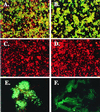Molecular strategies for interrupting arthropod-borne virus transmission by mosquitoes
- PMID: 11023962
- PMCID: PMC88954
- DOI: 10.1128/CMR.13.4.651
Molecular strategies for interrupting arthropod-borne virus transmission by mosquitoes
Abstract
Arthropod-borne virus (arbovirus) infections cause a number of emerging and resurgent human and veterinary infectious diseases. Traditional means of controlling arbovirus diseases include vaccination of susceptible vertebrates and mosquito control, but in many cases these have been unavailable or ineffective, and so novel strategies for disease control are needed. One possibility is genetic manipulation of mosquito vectors to render them unable to transmit arboviruses. This review describes recent work to test the concept of pathogen-derived resistance in arthropods by expression of viral genes in mosquito cell cultures and mosquitoes. Sense and antisense genome sequences from La Crosse virus (LAC) (a member of the Bunyaviridae) and dengue viruses serotypes 1 to 4 (DEN-1 to DEN-4) (members of the Flaviviridae) were expressed in mosquito cells from double-subgenomic and replicon vectors based on Sindbis virus (a member of the Togaviridae). The cells were then challenged with homologous or related viruses. For LAC, expression of antisense sequences from the small (S) genome segment, particularly full-length antisense S RNA, effectively interfered with replication of challenge virus, whereas expression of either antisense or sense RNA from the medium (M) segment was completely ineffective in LAC inhibition. Expression of sense and antisense RNA derived from certain regions of the DEN genome also blocked homologous virus replication more effectively than did RNA from other regions. Other parameters of RNA-mediated interference have been defined, such as the time when replication is blocked and the minimum size of effector RNA. The mechanism of RNA inhibition has not been determined, although it resembles double-stranded RNA interference in other nonvertebrate systems. Prospects for application of molecular strategies to control arbovirus diseases are briefly reviewed.
Figures

References
-
- Reference deleted.
-
- Afanasiev B N, Kozlov Y V, Carlson J O, Beaty B J. Densovirus of Aedes aegypti as an expression vector in mosquito cells. Exp Parasitol. 1994;79:322–339. - PubMed
-
- Afanasiev B N, Ward T W, Beaty B J, Carlson J O. Transduction of Aedes aegypti mosquitoes with vectors derived from Aedes densovirus. Virology. 1999;257:62–72. - PubMed
Publication types
MeSH terms
Substances
Grants and funding
LinkOut - more resources
Full Text Sources
Other Literature Sources
Medical

